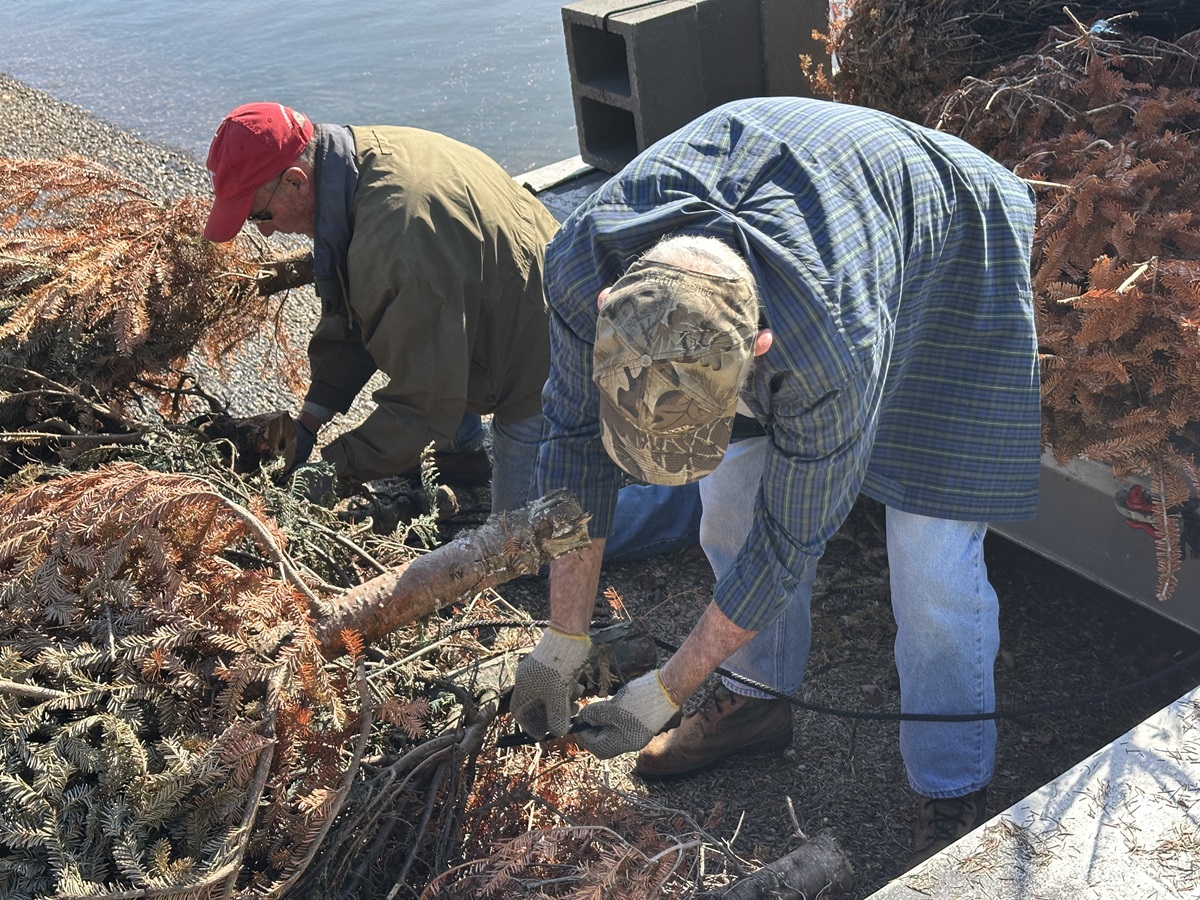Alabama ecologists on the prowl for shortleaf pine seeds to restore vanishing habitat

Volunteers harvest shortleaf pinecones as part of a growing movement to preserve and expand shortleaf habitat in Alabama. (Beth Maynor Finch)
Longleaf pines get far more attention, but the shortleaf ecosystem is just as rare, and vitally important.
Last fall, on the edge of a field in northeast Alabama, a small team of scientists and volunteers, sporting bright yellow hard hats, picked through the branches of a shortleaf pine tree.
They were collecting pinecones, and the seeds nestled within. It was one of several carefully selected spots where the cone-collecting process took place over a few short weeks across northern sections of the state and into Tennessee.
It’s not easy work.
Depending on the location, the teams deployed rented bucket trucks to rise safely into the lofty branches. Or they manipulated tall poles into the treetops from the ground – using the same equipment deployed by utility crews when working on power lines.
Even with all the planning and scheduling and hard work, not every shortleaf pine will bear the sought-after fruit. Sometimes, the pinecones will be too premature, or too old, to be of any use.
Despite the challenges, Bill Finch, founder and executive director of the Paint Rock Forest Research Center in Paint Rock, Alabama, said the 2023 shortleaf pinecone harvest was a relatively good one.
“We’re learning things all the time – surprising things. When to harvest, where to harvest. It can vary year by year, place to place.”
The team’s goal: to create a repository of several million shortleaf pine seeds from trees native to the region. And then, nurture the seeds into seedlings for planting, with the hope of slowly rebuilding shortleaf habitat that – for the most part – has disappeared from the landscape.
“It’s bizarre … we’ve really neglected it,” Finch said, noting that the genetics of shortleaf pine trees found in north Alabama and in the nearby Cumberland Valley of Tennessee are unlike those of shortleaf pines found anywhere else.
“We haven’t always been that kind to our forests,” Finch noted, considering the now-precarious condition of Alabama shortleaf pine forests.
And without a concerted effort, he worries, the region is “about to lose one of our most important genetic ingredients for our forests: the shortleaf.”
Shortleaf vs. longleaf
Over the past three decades or so, multiple organizations and nonprofits have focused significant resources on restoring another forest habitat that once blanketed much of the Southeast: the longleaf pine ecosystem. That effort is starting to pay off.
Reduced to 3% of its historic range because of a multiple factors – including use of the trees for turpentine production, followed by timbering and replacement with faster-growing commercial varieties of pine, as well as the suppression of natural fire that longleaf forests need to thrive – the longleaf pine is making a bit of a comeback in multiple Southern states, thanks to preservation efforts combined with a slow but steady expansion of new longleaf pine forests, on both public and private lands.
Shortleaf pines, however, haven’t received nearly the attention and funding that is now devoted to longleaf. Even though, Finch said, it has suffered a similar fate to that of the longleaf forests.
What’s more, shortleaf forests have much of the same important attributes that are now so well-known and appreciated in longleaf.

Shortleaf pine forest habitats are home to multiple important species. (Mississippi State University Extension Service / John Kushla)
Like longleaf, shortleaf forests are home to a tremendous diversity of plants and animals, some of them rare and potentially facing extinction without help.
Like longleaf, a mature shortleaf forest is stunningly beautiful – more like a savannah, with scattered towering trees that shelter multitudes of bird species. Below the tree canopy, the sun-dappled earth is a pasture-like haven for numerous species of grasses, wildflowers, and rare pitcher plants.
And, just like longleaf, shortleaf forests need fire, sparked naturally in pre-settlement days by lightning strikes. The fires burn off weedy thickets that prevent sunlight from nourishing the grasses and wildflowers on the forest floor, Finch said.
Today, that needed fire is being “prescribed” – set intentionally by experts to delicately slow-roast the terrain in a controlled manner. Both young shortleaf and longleaf pines are naturally built to withstand, and ultimately thrive, amid periodic fires. In fact, without the aid of fire, young trees won’t grow into maturity.
“We’ve got to get fire back in our landscape,” said Brad Nail, a regional forester with the Alabama Forestry Foundation, which promotes forest conservation, water quality protection, and habitat protection for at-risk wildlife across the state.
He said shortleaf forests not only house important habitat for a wealth of species. Shortleaf also grows well where longleaf won’t.
“It grows great on dry rocky ridges,” Nail said, and can thrive in poor soil.
Put it all together, Finch said, and shortleaf habitat constitutes a complementary ecosystem to longleaf forests that is arguably as important – or perhaps even more important.
But without a coordinated preservation campaign similar to the one now enjoyed by the longleaf, shortleaf forests are facing even greater fragmentation, Finch argues.
In Alabama, for example, Finch said only a few substantial stands of shortleaf forest remain. They are found in Macon County; in sections of the Conecuh and Talladega National Forests; and in and around the Little River National Wildlife Preserve in north Alabama. Ironically, another place where mature shortleaf pines can be found is in the more deeply forested areas of urban Birmingham and its close-in suburbs, where old shortleaf trees were spared from the saw.
Bottom line: “There’s almost no remnant examples of the shortleaf ecosystem,” which can contain “five or six varieties of sunflowers, high grass diversity, and wildlife so extraordinary – birds, grouse, elk, quail – just like longleaf,” Finch said.
“We’re about 20 years behind,” Finch said, comparing the restoration efforts around shortleaf to those of its longleaf cousin – which makes the need to preserve existing patches of shortleaf, and find a way to expand them, even more important.
A growing shortleaf movement
Two years ago, that effort received a boost when the nonprofit National Fish and Wildlife Foundation (NFWF), an organization that has been on the frontlines of longleaf restoration, awarded the Paint Rock Forest Research Center a grant to begin collecting shortleaf pine seeds.
To date, the center, with the help of partners and volunteers, has collected close to two million shortleaf seeds over two fall harvests. The NFWF grant is expected to support one more harvest, slated for fall 2024.
The Alabama Forestry Foundation also has received support from NFWF to work with private landowners to consider planting shortleaf.
He noted that the majority of Alabama’s 23 million acres of timberland are in private hands, and most of those private landowners maintain what he calls “family forests,” as opposed to those owned and managed by corporate interests. Family forest owners, he said, are more interested in preserving the land for subsequent generations of their family, versus earning a profit.
Planting shortleaf, he said, can be a great option for them. There’s even the potential for cost-sharing, through programs operated by the federal Natural Resources Conservation Service.
He said planting shortleaf and managing it with prescribed fire can be a cost-effective strategy for forest owners. The reason: Fire can replace more costly timber management plans that require periodic tree thinning and the use of store-bought fertilizers and herbicides.
“Fire does it all,” Nail said.

A prescribed fire in a shortleaf stand in Tennessee. (Clarence Coffee / Shortleaf Pine Initiative)
Nail and the Forestry Foundation are helping spread the gospel of shortleaf, particularly in north Alabama. with “learn and burn” events in which landowners can test out prescribed fire on their property, under the supervision of certified “burn bosses,” to learn about its benefits for multiple timber types, but especially for shortleaf. To learn more about upcoming learn and burn events, click here.
Ironically, Nail said a growing number of landowners are turning to shortleaf after having planted longleaf and seeing it fail; it turns out, they planted longleaf in places that are better suited to shortleaf.
“There’s a niche that shortleaf can fill,” Nail said.
He said a great resource for forest owners is the Alabama Landowner Resource Center, which provides expertise to help property owners develop a management plan for their land, at no cost. The Forestry Foundation is among the resource center partners, as is NFWF, the U.S. Forest Service, and the U.S. Fish and Wildlife Service.
Meanwhile, Finch said his team has gotten better at harvesting shortleaf seeds over the past two seasons. A viable shortleaf pinecone will usually contain between 20 and 25 seeds, with each seed representing, potentially, one shortleaf pine tree.

Harvesting shortleaf pinecones. (Sakora Smeby)

Harvesting shortleaf pinecones. (Beth Maynor Finch)
Finch believes about 80% of the seeds the team has collected under the grant are capable of sprouting into seedlings. In the interim, they are in refrigerated storage, where the seeds can remain viable for about five years – or longer if kept frozen.
The next step: finding the right places to plant shortleaf seedlings, with support from both public agencies, nonprofits, educational institutions and private landholders. Finch said a potential candidate to accept seedlings is the state of Alabama – for planting at sites protected by the state’s Forever Wild Land Trust.
Shortleaf forests: a site to behold
Finch said while they are hard to find, a mature shortleaf pine forest is a site to behold.
He said shortleaf pines will actually grow taller than longleaf, under the right conditions. They have broad trunks, sheathed in a pleasing mosaic of reddish bark plates that are typically larger than plates on other pines.
Also, unlike longleaf, mature shortleaf trees aren’t tapered at the top – which makes them ideal for use as utility poles – if there were enough around to supply the industry.
Like longleaf, shortleaf pines are considered a “high-value product,” Finch said, compared to loblolly pines, commonly grown for pulp. Getting that higher value means you have to let the trees grow longer. So, shortleaf forests are a longer-term investment if grown for commercial purposes. But in the meantime, landowners get the bonus of the broad spectrum of wildlife that shortleaf encourages. And, as Nail noted, there’s a growing share of landowners in Alabama who are less interested in growing trees for commercial purposes alone.
Finch agrees with Nail that there’s growing awareness around the benefits and importance of the shortleaf ecosystem, with more organizations beginning to discuss partnerships to support a broader preservation initiative.
Alabama Power, one of the state’s largest landowners, is among those taking a look at shortleaf. Company forester Wes Pruet said shortleaf is scattered among the company’s land holdings and can be planted in conjunction with other types of trees, such as certain hardwoods.
He said the company has ordered 15,000 shortleaf seedlings for planting later this year, with a goal of managing over 1,000 acres of shortleaf on company lands by the end of the decade.
Meanwhile, Finch and his small team will continue to collect the shortleaf seeds – those tiny, all-important components needed to grow the movement to restore the Southeast’s shortleaf forests.












